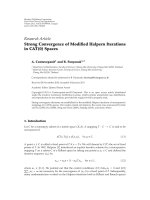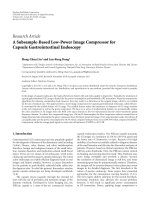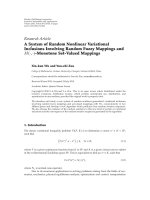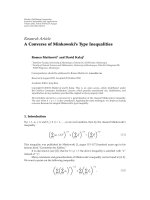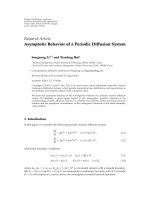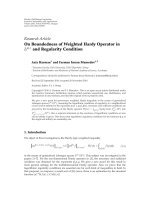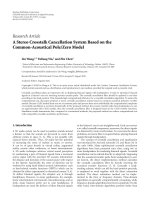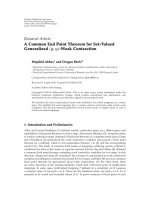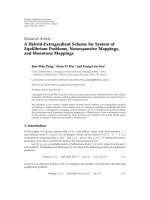Báo cáo hóa học: " Research Article A System of Random Nonlinear Variational Inclusions Involving Random Fuzzy Mappings " docx
Bạn đang xem bản rút gọn của tài liệu. Xem và tải ngay bản đầy đủ của tài liệu tại đây (537.72 KB, 17 trang )
Hindawi Publishing Corporation
Journal of Inequalities and Applications
Volume 2010, Article ID 123524, 17 pages
doi:10.1155/2010/123524
Research Article
A System of Random Nonlinear Variational
Inclusions Involving Random Fuzzy Mappings and
H·, ·-Monotone Set-Valued Mappings
Xin-kun Wu and Yun-zhi Zou
College of Mathematics, Sichuan University, Chengdu, Sichuan 610064, China
Correspondence should be addressed to Yun-zhi Zou,
Received 8 June 2010; Accepted 24 July 2010
Academic Editor: Qamrul Hasan Ansari
Copyright q 2010 X k. Wu and Y z. Zou. This is an open access article distributed under the
Creative Commons Attribution License, which permits unrestricted use, distribution, and
reproduction in any medium, provided the original work is properly cited.
We introduce and study a new system of random nonlinear generalized variational inclusions
involving random fuzzy mappings and set-valued mappings with H·, ·-monotonicity in two
Hilbert spaces and develop a new algorithm which produces four random iterative sequences.
We also discuss the existence of the random solutions to this new kind of system of variational
inclusions and the convergence of the random iterative sequences generated by the algorithm.
1. Introduction
The classic variational inequality problem VIF, K is to determine a vector x
∗
∈ K ⊂ R
n
,
such that
F
x
∗
T
,x− x
∗
≥ 0, ∀x ∈ K, 1.1
where F is a given continuous function from K to R
n
and K is a given closed convex subset
of the n-dimensional Euclidean space R
n
. This is equivalent to find an x
∗
∈ K, such that
0 ∈ F
x
∗
N
⊥
x
∗
, 1.2
where N
⊥
is normal cone operator.
Due to its enormous applications in solving problems arising from the fields of eco-
nomics, mechanics, physical equilibrium analysis, optimization and control, transportation
2 Journal of Inequalities and Applications
equilibrium, and linear or nonlinear programming etcetera, variational inequality and its
generalizations have been extensively studied during the past 40 years. For details, we refer
readers to 1–7 and the references therein.
It is not a surprise that many practical situations occur by chance and so variational
inequalities with random variables/mappings have also been widely studied in the past
decade. For instance, some random variational inequalities and random quasivariational
inequalities problems have been introduced and studied by Chang 8, Chang and Huang
9, 10, Chang and Zhu 11, Huang 12, 13, Husain et al. 14, Tan et al. 15,Tan16,and
Yuan 7.
It is well known that one of the most important and interesting problems in the theory
of variational inequalities is to develop efficient and implementable algorithms for solving
variational inequalities and its generalizations. The monotonic properties of associated
operators play essential roles in proving the existence of solutions and the convergence of
sequences generated by iterative algorithms. In 2001, Huang and Fang 17 were t he first
to introduce the generalized m-accretive mapping and give the definition of the resolvent
operator for generalized m-accretive mappings in Banach spaces. They also showed some
properties of the resolvent operator for generalized m-accretive mappings. Recently, Fang
and Huang, Verma, and Cho and Lan investigated many generalized operators such as H-
monotone, H-accretive, H, η-monotone, H, η-accretive, and A, η-accretive mappings.
For details, we refer to 6, 17–22 and the references therein. In 2008, Zou and Huang
23 introduced the H
·, ·-accretive operator in Banach spaces which provides a unified
framework for the existing H-monotone, H, η-monotone, and A, η-monotone operators
in Hilbert spaces and H-accretive, H, η-accretive, and A, η-accretive operators in Banach
spaces.
In 1965, Zadeh 24 introduced the concept of fuzzy sets, which became a cornerstone
of modern fuzzy mathematics. To explore connections among VIs, fuzzy mapping
and random mappings, in 1997, Huang 25 introduced the concept of random fuzzy
mappings and studied the random nonlinear quasicomplementarity problem for random
fuzzy mappings. Later, Huang 26 studied the random generalized nonlinear variational
inclusions for random fuzzy mappings. In 2005, Ahmad and Baz
´
an 27 studied a class of
random generalized nonlinear mixed variational inclusions for random fuzzy mappings and
constructed an iterative algorithm for solving such random problems. For related work in
this hot area, we refer to Ahmad and Farajzadeh 28, Ansari and Yao 29, Chang and Huang
9, 10, Cho and Huang 30, Cho and Lan 31, Huang 25, 26, 32, Huang et al. 33,andthe
references therein.
Motivated and inspired by recent research work mentioned above in this field, in this
paper, we t ry to inject some new energy into this interesting field by studying on a new kind
of random nonlinear variational inclusions in two Hilbert spaces. We will prove the existence
of random solutions to the system of inclusions and propose an algorithm which produces a
convergent iterative sequence. For a suitable choice of some mappings, we can obtain several
known results 10, 11, 21,
23, 31, 34 as special cases of the main results of this paper.
2. Preliminaries
Throughout this paper, let Ω, A be a measurable space, where Ω is a set and A is a σ-algebra
over Ω.LetX
1
be a separable real Hilbert space endowed with a norm ·
X
1
and an inner
product ·, ·
X
1
.LetX
2
be a separable real Hilbert space endowed with a norm ·
X
2
and an
inner product ·, ·
X
2
.
Journal of Inequalities and Applications 3
We denote by D·, · the Hausdorff metric between two nonempty closed bounded
subsets, where the Hausdorff metric between A and B is defined by
D
A, B
max
sup
a∈A
inf
b∈B
d
a, b
, sup
b∈B
inf
a∈A
d
a, b
. 2.1
We denote by BX
1
,2
X
1
,andCBX
1
the class of Borel σ-fields in X
1
, and the family
of all nonempty subsets of X
1
, the family of all nonempty closed bounded subsets of X
1
.
In this paper, to make it self-contained, we start with the following basic definitions
and similar definitions can also be found in 26, 32, 34.
Definition 2.1. A mapping x
1
: Ω → X
1
is said to be measurable if for any B ∈BX
1
,
{
t ∈ Ω : x
t
∈ B
}
∈A. 2.2
Definition 2.2. A mapping T
1
: Ω × X
1
→ X
1
is called a random mapping if for any x ∈ X
1
,
z
1
tT
1
t, x is measurable.
Definition 2.3. A random mapping T
1
: Ω × X
1
→ X
1
is said to be continuous if for any t ∈ Ω,
T
1
t, · : X
1
→ X
1
is continuous.
Definition 2.4. A set-valued mapping V
1
: Ω → 2
X
1
is said to be measurable if for any B ∈
BX
1
,
V
−1
1
B
{
v ∈ Ω : V
1
v
∩ B
/
∅
}
∈A. 2.3
Definition 2.5. A mapping u : Ω → X
1
is called a measurable selection of a set-valued
measurable mapping U : Ω → 2
X
1
if u is measurable and for any t ∈ Ω, ut ∈ Ut.
Definition 2.6. A set-valued mapping W
1
: Ω × X
1
→ 2
X
1
is called random set-valued if for
any x
1
∈ X
1
, W
1
·,x
1
: Ω → 2
X
1
is a measurable set valued mapping.
Definition 2.7. A random set-valued mapping W
1
: Ω × X
1
→ CBX
1
is said to be ξ
E
t-D-
continuous if there exists a measurable function ξ
E
: Ω → 0, ∞, such that
D
W
1
t, x
1
t
,W
1
t, x
2
t
≤ ξ
E
t
x
1
t
− x
2
t
X
1
, 2.4
for all t ∈ Ω and x
1
t,x
2
t ∈ X
1
.
Definition 2.8. A set-valued mapping A : X
1
→ 2
X
1
is said to be monotone if for all x
1
,y
1
∈ X
1
and u
1
∈ Ax
1
, v
1
∈ Ay
1
,
u
1
− v
1
,x
1
− y
1
X
1
≥ 0.
2.5
Definition 2.9. Let f
1
,g
1
: X
1
→ X
1
and H
1
: X
1
× X
1
→ X
1
be three single-valued mappings
and A : X
1
→ 2
X
1
be a set-valued mapping. A is said to be H
1
·, ·-monotone with respect to
operators f
1
and g
1
if A is monotone and H
1
f
1
,g
1
λAX
1
X
1
, for every λ>0.
4 Journal of Inequalities and Applications
Definition 2.10. The inverses of A : X
1
→ 2
X
1
and B : X
2
→ 2
X
2
are defined as follows,
respectively,
A
−1
y
x ∈ X
1
: y ∈ A
x
, ∀y ∈ X
1
,
B
−1
y
x ∈ X
2
: y ∈ B
x
, ∀y ∈ X
2
.
2.6
Definition 2.11. p : Ω × X
1
→ X
1
is said to be
1 monotone if
p
t, x
1
t
− p
t, x
2
t
,x
1
t
− x
2
t
X
1
≥ 0, ∀t ∈ Ω, ∀x
1
t
,x
2
t
∈ X
1
,
2.7
2 strictly monotone if p is monotone and
p
t, x
1
t
− p
t, x
2
t
,x
1
t
− x
2
t
X
1
0 ⇐⇒ x
1
t
x
2
t
, ∀t ∈ Ω, ∀x
1
t
,x
2
t
∈ X
1
,
2.8
3 δ
p
t-strongly monotone if there exists some measurable function δ
p
: Ω →
0, ∞, such that
p
t, x
1
t
− p
t, x
2
t
,x
1
t
− x
2
t
X
1
≥ δ
p
t
x
1
t
− x
2
t
2
x
1
, ∀t ∈ Ω, ∀x
1
t
,x
2
t
∈ X
1
,
2.9
4 σ
p
t-Lipschitz continuous if there exists some measurable function σ
p
: Ω →
0, ∞, such that
pt, x
1
t − p
t, x
2
t
X
1
≤ σ
p
t
x
1
t − x
2
t
X
1
, ∀t ∈ Ω, ∀x
1
t
,x
2
t
∈ X
1
.
2.10
Definition 2.12. A single-valued mapping M : X
1
× X
1
× X
2
→ X
1
is said to be
1 ζ
A
t-strongly monotone with respect to the random single-valued mapping s
M
:
Ω × X
1
→ X
1
in the first argument if there exists some measurable function ζ
A
:
Ω → 0, ∞, such that
M
s
M
t, u
1
t
, ·, ·
− M
s
M
t, u
2
t
, ·, ·
,u
1
t
− u
2
t
X
1
≥ ζ
A
t
u
1
t
− u
2
t
2
X
1
,
2.11
for all t ∈ Ω and u
1
t,u
2
t ∈ X
1
,
2 ξ
M
t-Lipschitz continuous with respect to the random single-valued mapping s
M
:
Ω × X
1
→ X
1
in its fi rst argument if there exists some measurable function ξ
M
:
Ω → 0, ∞, such that
Ms
M
t, u
1
t, ·, · − Ms
M
t, u
2
t, ·, ·
X
1
≤ ξ
M
t
u
1
t − u
2
t
X
1
, 2.12
for all t ∈ Ω and u
1
t,u
2
t ∈ X
1
,
Journal of Inequalities and Applications 5
3 β
M
t-Lipschitz continuous with respect to its second argument if there exists some
measurable function β
M
: Ω → 0, ∞, such that
M·,x
1
t, · − M·,x
2
t, ·
X
1
≤ β
M
t
x
1
t − x
2
t
X
1
, 2.13
for all t ∈ Ω and x
1
t,x
2
t ∈ X
1
,
4 η
M
t-Lipschitz continuous with respect to its third argument if there exists some
measurable function η
M
: Ω → 0, ∞ such that
M·, ·,y
1
t − M
·, ·,y
2
t
X
1
≤ η
M
t
y
1
t − y
2
t
X
2
,
2.14
for all t ∈ Ω and y
1
t,y
2
t ∈ X
2
;
Definition 2.13. Assume that p : Ω × X
1
→ X
1
is a random single-valued mapping, f
1
: X
1
→
X
1
, g
1
: X
1
→ X
1
,andH
1
f
1
,g
1
: X
1
→ X
1
are three single-valued mappings, H
1
f
1
,g
1
is
said to be
1 μ
A
t-strongly monotone with respect to the mapping p if there exists some
measurable function μ
A
: Ω → 0, ∞ such that
H
1
f
1
p
t, x
1
t
,g
1
p
t, x
1
t
− H
1
f
1
p
t, y
1
t
,g
1
p
t, y
1
t
,x
1
t
− y
1
t
X
1
≥ μ
A
t
x
1
t
− y
1
t
2
X
1
,
2.15
for all t ∈ Ω and x
1
t,y
1
t ∈ X
1
,
2 a
A
t-Lipschitz continuous with respect to the mapping p if there exists some
measurable function a
A
: Ω → 0, ∞ such that
H
1
f
1
p
t, x
1
t
,g
1
p
t, x
1
t
− H
1
f
1
p
t, y
1
t
,g
1
p
t, y
1
t
X
1
≤ a
A
t
x
1
t
− y
1
t
X
1
,
2.16
for all t ∈ Ω and x
1
t,y
1
t ∈ X
1
.
3 α
A
-strongly monotone with respect to f
1
in the first argument if there exists a
positive constant α
A
, such that
H
1
f
1
x
1
,u
1
− H
1
f
1
y
1
,u
1
,x
1
− y
1
X
1
≥ α
A
x
1
− y
1
2
X
1
,
2.17
for all x
1
,y
1
,u
1
∈ X
1
,
6 Journal of Inequalities and Applications
4 β
A
-relaxed monotone with respect to g
1
in the second argument if there exists a
positive constant β
A
, such that
H
1
u
1
,g
1
x
1
− H
1
u
1
,g
1
y
1
,x
1
− y
1
X
1
≥−β
A
x
1
− y
1
2
X
1
,
2.18
for all x
1
,y
1
,u
1
∈ X
1
.
Let FX
1
be a collection of all fuzzy sets over X
1
. A mapping F from Ω into FX
1
is
called a fuzzy mapping. If F is a f uzzy mapping on X
1
, then for any given t ∈ Ω, Ftdenote
it by F
t
in the sequel is a fuzzy set on X
1
and F
t
y is the membership function of y in F
t
.
Let A ∈FX
1
, α ∈ 0, 1, then the set
A
α
{
x ∈ X
1
: A
x
≥ α
}
2.19
is called an α-cut set of fuzzy set A.
Definition 2.14. A random fuzzy mapping F : Ω →FX
1
is said to be measurable if for any
given α ∈ 0, 1, F·
α
: Ω → 2
X
1
is a measurable set-valued mapping.
Definition 2.15. A fuzzy mapping E : Ω × X
1
→FX
1
is called a random fuzzy mapping if
for any given x
1
∈ X
1
, E·,x
1
: Ω →FX
1
is a measurable fuzzy mapping.
Remark 2.16. The above is mainly about some definitions in X
1
. There are similar definitions
and notations for operators in X
2
.
Let E : Ω × X
1
→FX
1
and F : Ω × X
2
→FX
2
be two random fuzzy mappings
satisfying the following condition ∗∗:
∗∗ there exist two mappings α : X
1
→ 0, 1 and β : X
2
→ 0, 1, such that
E
t,x
1
αx
1
∈ CB
X
1
, ∀
t, x
1
∈ Ω × X
1
,
F
t,x
2
βx
2
∈ CB
X
2
, ∀
t, x
2
∈ Ω × X
2
.
2.20
By using the random fuzzy mappings E and F, we can define the two set-valued
mappings E
∗
and F
∗
as follows, respectively,
E
∗
: Ω × X
1
−→ CB
X
1
,
t, x
1
−→
E
t,x
1
αx
1
, ∀
t, x
1
∈ Ω × X
1
,
F
∗
: Ω × X
2
−→ CB
X
2
,
t, x
2
−→
E
t,x
2
αx
2
, ∀
t, x
2
∈ Ω × X
2
.
2.21
It follows that
E
∗
t, x
1
E
t,x
1
αx
1
{
z
1
∈ X
1
:
E
t,x
1
z
1
≥ α
x
1
}
,
F
∗
t, x
2
F
t,x
2
βx
2
z
2
∈ X
2
:
F
t,x
2
z
2
≥ β
x
2
.
2.22
It is easy to see that E
∗
and F
∗
are two random set-valued mappings. We call E
∗
and F
∗
the
random set-valued mappings induced by the fuzzy mappings E and F, respectively.
Journal of Inequalities and Applications 7
Problem 1. Let f
1
,g
1
: X
1
→ X
1
be two single-valued mappings and s
M
,p : Ω × X
1
→ X
1
be
two random single-valued mappings. Let f
2
,g
2
: X
2
→ X
2
be two single-valued mappings
and s
N
,q : Ω × X
2
→ X
2
be two random single-valued mappings. Let H
1
: X
1
× X
1
→ X
1
,
H
2
: X
2
× X
2
→ X
2
, M : X
1
× X
1
× X
2
→ X
1
and N : X
2
× X
1
× X
2
→ X
2
be four single-
valued mappings. Suppose that A : X
1
→ 2
X
1
is an H
1
·, ·-monotone mapping with respect
to f
1
and g
1
and B : X
2
→ 2
X
2
is an H
2
·, ·-monotone mapping with respect to f
2
and g
2
.
E : Ω × X
1
→FX
1
and F : Ω × X
2
→FX
2
are two random fuzzy mappings, α, β, E
∗
,and
F
∗
are the same as the above. Assume that pt, ut ∩ domA
/
∅ and qt, vt ∩ domB
/
∅
for all t ∈ Ω. We consider the following problem.
Find four measurable mappings u, x : Ω → X
1
and v,y : Ω → X
2
, such that
E
t,ut
x
t
≥ α
u
t
,
F
t,vt
y
t
≥ β
v
t
,
0 ∈ M
s
M
t, u
t
,x
t
,y
t
A
p
t, u
t
,
0 ∈ N
s
N
t, v
t
,x
t
,y
t
B
q
t, v
t
,
2.23
for all t ∈ Ω.
Problem 1 is called a system of generalized random nonlinear variational inclusions
involving random fuzzy mappings and set-valued mappings with H·, ·-monotonicity in
two Hilbert spaces. A set of the four measurable mappings x, y, u, and v is called one solution
of Problem 1.
3. Random Iterative Algorithm
In order to prove the main results, we need the following lemmas.
Lemma 3.1 see 23. Let H
1
, f
1
, g
1
, and A be defined as in Problem 1.LetH
1
f
1
,g
1
be α
A
-
strongly monotone with respect to f
1
, β
A
-relaxed monotone with respect to g
1
,whereα
A
>β
A
.
Suppose that A : X
1
→ 2
X
1
is an H
1
·, ·-monotone set-valued mapping with respect to f
1
and
g
1
, then the resolvent operator R
H
1
·,·
A,λ
Hf, gλA
−1
is a single-valued mapping.
Lemma 3.2 see 23. Let H
1
, f
1
, g
1
, A be defined as in Problem 1.LetH
1
f
1
,g
1
be α
A
-strongly
monotone with respect to f
1
, β
A
-relaxed monotone with respect to g
1
,whereα
A
>β
A
. Suppose that
A : X
1
→ 2
X
1
is an H
1
·, ·-monotone set-valued mapping with respect to f
1
and g
1
. Then, the
resolvent operator R
H
1
·,·
A,λ
is 1/α
A
− β
A
-Lipschitz continuous.
Remark 3.3. Some interesting examples concerned with the H
1
·, ·-monotone mapping and
the resolvent operator R
H
1
·,·
A,λ
can be found in 23.
Lemma 3.4 see Chang 8. Let V : Ω × X
1
→ CBX
1
be a D-continuous random set-valued
mapping. Then for any given measurable mapping u : Ω → X
1
, the set-valued mapping V ·,u· :
Ω → CBX
1
is measurable.
8 Journal of Inequalities and Applications
Lemma 3.5 see Chang 8. Let V, W : Ω → CBX
1
be two measurable set-valued mappings,
and let ε>0 be a constant and u : Ω → X
1
a measurable selection of V . Then there exists a
measurable selection v : Ω → X
1
of W, such that for all t ∈ Ω,
u
t
− v
t
≤
1 ε
D
V
t
,W
t
. 3.1
Lemma 3.6. The four measurable mappings x, u : Ω → X
1
and y, v : Ω → X
2
are solution of
Problem 1 if and only if, for all t ∈ Ω,
x
t
∈ E
∗
t, u
t
,
x
t
∈ F
∗
t, v
t
,
p
t, u
t
R
H
1
·,·
A,λ
H
1
f
1
p
t, u
t
,g
1
p
t, u
t
− λM
s
M
t, u
t
,x
t
,y
t
,
q
t, u
t
R
H
2
·,·
B,ρ
H
2
f
2
q
t, v
t
,g
2
q
t, v
t
− ρN
s
N
t, v
t
,x
t
,y
t
,
3.2
where R
H
1
·,·
A,λ
H
1
f
1
,g
1
λA
−1
and R
H
2
·,·
B,ρ
H
2
f
2
,g
2
ρB
−1
are two resolvent operators.
Proof. From the definitions of R
H
1
·,·
A,λ
and R
H
2
·,·
B,ρ
, one has
H
1
f
1
p
t, u
t
,g
1
p
t, u
t
− λM
s
M
t, u
t
,x
t
,y
t
∈ H
1
f
1
p
t, u
t
,g
1
p
t, u
t
λA
p
t, u
t
, ∀t ∈ Ω,
H
2
f
2
q
t, v
t
,g
2
q
t, v
t
− ρN
s
N
t, v
t
,x
t
,y
t
∈ H
2
f
2
q
t, v
t
,g
2
q
t, v
t
ρB
q
t, v
t
, ∀t ∈ Ω.
3.3
Hence,
0 ∈ M
s
M
t, u
t
,x
t
,y
t
A
p
t, u
t
, ∀t ∈ Ω,
0 ∈ N
s
N
t, v
t
,x
t
,y
t
B
q
t, v
t
, ∀t ∈ Ω.
3.4
Thus, x, y, u, v is a set of solution of Problem 1. This completes the proof.
Now we use Lemma 3.6 to construct the following algorithm.
Let u
0
: Ω → X
1
and v
0
: Ω → X
2
be two measurable mappings, then by Himmelberg
35, there exist x
0
: Ω → X
1
, a measurable selection of E
∗
·,u
0
· : Ω → CBX
1
and
y
0
: Ω → X
2
, a measurable selection of F
∗
·,v
0
· : Ω → CBX
2
. We now propose the
following algorithm.
Journal of Inequalities and Applications 9
Algorithm 3.7. For any given measurable mappings u
0
: Ω → X
1
and v
0
: Ω → X
2
, iterative
sequences that attempt to solve Problem 1 are defined as follows:
u
n1
t
u
n
t
− p
t, u
n
t
R
H
1
·,·
A,λ
H
1
f
1
p
t, u
n
t
,g
1
p
t, u
n
t
− λM
s
M
t, u
n
t
,x
n
t
,y
n
t
,
v
n1
t
v
n
t
− q
t, v
n
t
R
H
2
·,·
B,ρ
H
2
f
2
q
t, v
n
t
,g
2
q
t, v
n
t
− ρN
s
N
t, v
n
t
,x
n
t
,y
n
t
.
3.5
Choose x
n1
t ∈ E
∗
t, u
n1
t and y
n1
t ∈ F
∗
t, v
n1
t, such that
x
n1
t − x
n
t
X
1
≤
1 ε
n1
D
E
∗
t, u
n1
t
,E
∗
t, u
n
t
,
y
n1
t − y
n
t
X
2
≤
1 ε
n1
D
F
∗
t, v
n1
t
,F
∗
t, v
n
t
,
3.6
for any t ∈ Ω and n 0, 1, 2, 3,
Remark 3.8. The existence of x
n
and y
n
is guaranteed by Lemmas 3.4 and 3.5.
4. Existence and Convergence
Theorem 4.1. Let X
1
and X
2
be two separable real Hilbert spaces. Suppose that s
M
,p: Ω×X
1
→ X
1
and s
N
,q : Ω × X
2
→ X
2
are four random mappings. Suppose that f
1
,g
1
: X
1
→ X
1
, H
1
:
X
1
× X
1
→ X
1
, f
2
,g
2
: X
2
→ X
2
, H
2
: X
2
× X
2
→ X
2
are six single-valued mappings. Assume
that
1 A : X
1
→ 2
X
1
is an H
1
·, ·-monotone with respect to operators f
1
and g
1
,
2 B : X
2
→ 2
X
2
is an H
2
·, ·-monotone with respect to operators f
2
and g
2
,
3 pt, ut ∩ domA
/
∅ and qt, vt ∩ domB
/
∅ for all t ∈ Ω,
4 M : X
1
× X
1
× X
2
→ X
1
is ζ
A
t-monotone with respect to the mapping s
M
in the first
argument, ξ
M
t-Lipschitz continuous with respect to mapping s
M
in the first argument,
β
M
t-Lipschitz continuous with respect to the second argument and η
M
t-Lipschitz
continuous with respect to the third argument,
5 N : X
2
× X
1
× X
2
→ X
2
is ζ
B
t-monotone with respect to the mapping s
N
in the first
argument, ξ
N
t-Lipschitz continuous with respect to mapping s
N
in the first argument,
β
N
t-Lipschitz continuous with respect to the second argument and η
N
t-Lipschitz
continuous with respect to the third argument,
6 Let E : Ω × X
1
→FX
1
and F : Ω × X
2
→FX
2
be two random fuzzy mappings
satisfying the condition ∗∗, α, β, E
∗
and F
∗
are four mappings induced by E and F. E
∗
and F
∗
are ξ
E
t-D-Lipschitz and ξ
F
t-D-Lipschitz continuous, respectively;
7 p is δ
p
t-strongly monotone with respect to its second argument, σ
p
t-Lipschitz
continuous with respect to its second argument, H
1
f
1
,g
1
is μ
A
t-strongly monotone
10 Journal of Inequalities and Applications
with respect to the mapping p and a
A
t-Lipschitz continuous with respect to the mapping
p,
8 H
1
f
1
,g
1
is α
A
-strongly monotone with respect to f
1
, and β
A
-relaxed monotone with
respect to g
1
,whereα
A
>β
A
,
9 q is δ
q
t-strongly monotone with respect to its second argument and σ
q
t-Lipschitz
continuous with respect to its second argument, H
2
f
2
,g
2
is μ
B
t-strongly monotone
with respect to the mapping q, and a
B
t-Lipschitz continuous with respect to the mapping
q,
10 H
2
f
2
,g
2
is α
B
-strongly monotone with respect to f
2
and β
B
-relaxed monotone with
respect to g
2
,whereα
B
>β
B
,
If
A
t
λ
α
A
− β
A
β
M
t
ξ
E
t
2
1 − 2δ
p
t
σ
p
t
2
1
α
A
− β
A
2
1 − 2μ
A
t
a
A
t
2
1
α
A
− β
A
2
1 − 2λζ
A
t
λ
2
ξ
M
t
2
,
B
t
λ
α
A
− β
A
η
M
t
ξ
F
t
,
C
t
ρ
α
B
− β
B
β
N
t
ξ
E
t
,
D
t
ρ
α
B
− β
B
η
N
t
ξ
F
t
2
1 − 2δ
q
t
σ
q
t
2
1
α
B
− β
B
2
1 − 2μ
B
t
a
B
t
2
1
α
B
− β
B
2
1 − 2ρζ
B
t
ρ
2
ξ
N
t
2
,
0 <A
t
C
t
< 1, ∀t ∈ Ω,
0 <B
t
D
t
< 1, ∀t ∈ Ω,
4.1
then there exist four measurable mappings x, u : Ω → X
1
and y,v : Ω → X
2
,such
that x, y, u, v is a set of solution of Problem 1. Moreover,
lim
n →∞
x
n
t
x
t
, lim
n →∞
y
n
t
y
t
, lim
n →∞
u
n
t
u
t
, lim
n →∞
v
n
t
v
t
,
4.2
where x
n
t, y
n
t, u
n
t, and v
n
t are defined as in Algorithm 3.7.
Journal of Inequalities and Applications 11
Proof. To simplify calculations, for any n ∈ N,welet
s
n
t
H
1
f
1
p
t, u
n
t
,g
1
p
t, u
n
t
− λM
s
M
t, u
n
t
,x
n
t
,y
n
t
,
t
n
t
H
2
f
2
q
t, v
n
t
,g
2
q
t, v
n
t
− ρN
s
N
t, v
n
t
,x
n
t
,y
n
t
,
4.3
S
n
t
−p
t, u
n
t
R
H
1
·,·
A,λ
s
n
t
,T
n
t
−q
t, v
n
t
R
H
2
·,·
B,ρ
t
n
t
.
4.4
We use ·
1
to replace ·
X
1
and ·
2
to replace ·
X
2
.
Thus,
u
n1
t
u
n
t
S
n
t
, 4.5
v
n1
t
v
n
t
T
n
t
. 4.6
By the definition of S
n
t, T
n
t, s
n
,andt
n
,wehavethefollowing
S
n
t
1
S
n−1
tS
n
t − S
n−1
t
1
u
n
t − u
n−1
t S
n
t − S
n−1
t
1
≤
u
n
t − u
n−1
t − pt, u
n
t − pt, u
n−1
t
1
R
H
1
·,·
A,λ
s
n
t
− R
H
1
·,·
A,λ
s
n−1
t
1
,
4.7
T
n
t
2
T
n−1
tT
n
t − T
n−1
t
2
v
n
t − v
n−1
t T
n
t − T
n−1
t
2
≤
v
n
t − v
n−1
t −
q
t, v
n
t
− q
t, v
n−1
t
2
R
H
2
·,·
B,ρ
t
n
t − R
H
2
·,·
B,ρ
t
n−1
t
2
.
4.8
We first prove that for the two sequences u
n
t and v
n
t, there exist two sequences
{A
n
t} and {B
n
t} in 0, 1, such that
u
n1
t − u
n
t
1
≤ A
n
t
u
n
t − u
n−1
t
1
B
n
t
v
n
t − v
n−1
t
2
. 4.9
In fact, for the first term in 4.7,fromtheδ
p
t-strongly monotonicity and σ
p
t-Lipschitz
continuity of the function p,wehavethefollowing:
u
n
t − u
n−1
t − pt, u
n
t − pt, u
n−1
t
2
1
u
n
t − u
n−1
t
2
1
− 2
p
t, u
n
t
− p
t, u
n−1
t
,u
n
t
− u
n−1
t
1
pt, u
n
t − pt, u
n−1
t
2
1
≤
1 − 2δ
p
t
σ
p
t
2
u
n
t
− u
n−1
t
2
1
.
4.10
12 Journal of Inequalities and Applications
For the second term in 4.7, it follows from Lemma 3.2 that
R
H
1
·,·
A,λ
s
n
t − R
H
1
·,·
A,λ
s
n−1
t
1
≤
1
α
A
− β
A
s
n
t − s
n−1
t
1
≤
1
α
A
− β
A
H
1
f
1
p
t, u
n
t
,g
1
p
t, u
n
t
− λM
s
M
t, u
n
t
,x
n
t
,y
n
t
−
H
1
f
1
p
t, u
n−1
t
,g
1
p
t, u
n−1
t
−λM
s
M
t, u
n−1
t
,x
n−1
t
,y
n−1
t
1
≤
1
α
A
− β
A
×
u
n
t
− u
n−1
t
−
H
1
f
1
p
t, u
n
t
,g
1
p
t, u
n
t
−H
1
f
1
p
t, u
n−1
t
,g
1
p
t, u
n−1
t
1
−u
n
t−u
n−1
t−λ
M
s
M
t, u
n
t
,x
n
t
,y
n
t
−M
s
M
t, u
n−1
t
,x
n
t
,y
n
t
1
λ
Ms
M
t, u
n−1
t,x
n
t,y
n
t − M
s
M
t, u
n−1
t
,x
n−1
t
,y
n
t
1
λ
M
s
M
t, u
n−1
t
,x
n−1
t
,y
n
t
− M
s
M
t, u
n−1
t
,x
n−1
t
,y
n−1
t
1
.
4.11
There are four terms in 4.11. Since H
1
f
1
,g
1
is μ
A
t-strongly monotone and a
A
t-
Lipschitz continuous with respect to the mapping p, then for the first term in 4.11, we can
obtain the following
u
n
t−u
n−1
t−H
1
f
1
p
t, u
n
t
,g
1
p
t, u
n
t
H
1
f
1
p
t, u
n−1
t
,g
1
p
t, u
n−1
t
2
1
u
n
t
− u
n−1
t
2
1
− 2
H
1
f
1
p
t, u
n
t
,g
1
p
t, u
n
t
−H
1
f
1
p
t, u
n−1
t
,g
1
p
t, u
n−1
t
,u
n
t − u
n−1
t
1
H
1
f
1
p
t, u
n
t
,g
1
p
t, u
n
t
− H
1
f
1
p
t, u
n−1
t
,g
1
p
t, u
n−1
t
2
1
≤
1 − 2μ
A
t
a
A
t
2
u
n
t − u
n−1
t
2
1
.
4.12
For the second term, Since M is ζ
A
t-monotone with respect to the mapping s
M
in the first
argument and ξ
M
t-Lipschitz continuous with respect to mapping s
M
in the first argument,
Journal of Inequalities and Applications 13
so
u
n
t − u
n−1
t − λ
M
s
M
t, u
n
t
,x
n
t
,y
n
t
− M
s
M
t, u
n−1
t
,x
n
t
,y
n
t
2
1
u
n
t − u
n−1
t
2
1
− 2λ
M
s
M
t, u
n
t
,x
n
t
,y
n
t
−M
s
M
t, u
n−1
t
,x
n
t
,y
n
t
,u
n
t
− u
n−1
t
1
λ
2
M
s
M
t, u
n
t
,x
n
t
,y
n
t
− M
s
M
t, u
n−1
t
,x
n
t
,y
n
t
2
1
≤
u
n
t − u
n−1
t
2
1
− 2λζ
A
t
u
n
t − u
n−1
t
2
1
λ
2
ξ
M
t
2
u
n
t
− u
n−1
t
2
1
≤
1 − 2λζ
A
t
λ
2
ξ
M
t
2
u
n
t
− u
n−1
t
2
1
.
4.13
For the third term, M is β
M
t-Lipschitz continuous with respect to the second argument and
E
∗
is ξ
E
t-D-Lipschitz continuous, therefore, we must have the following:
Ms
M
t, u
n−1
t,x
n
t,y
n
t − Ms
M
t, u
n−1
t,x
n−1
t,y
n
t
1
≤ β
M
t
x
n
t − x
n−1
t
1
≤ β
M
t
1 ε
n
D
E
∗
t, u
n
t
,E
∗
t, u
n−1
t
≤ β
M
t
1 ε
n
ξ
E
t
u
n
t − u
n−1
t
1
.
4.14
Similarly, because η
M
t-Lipschitz continuous with respect to the third argument and F
∗
is
ξ
F
t-D-Lipschitz continuous, so we can derive
M
s
M
t, u
n−1
t
,x
n−1
t
,y
n
t
− M
s
M
t, u
n−1
t
,x
n−1
t
,y
n−1
t
1
≤ η
M
t
y
n
t − y
n−1
t
2
≤ η
M
t
1 ε
n
D
F
∗
t, v
n
t
,F
∗
t, v
n−1
t
≤ η
M
t
1 ε
n
ξ
F
t
v
n
t − v
n−1
t
2
.
4.15
If we let
A
n
t
λ
α
A
− β
A
β
M
t
1 ε
n
ξ
E
t
2
1 − 2δ
p
t
σ
p
t
2
1
α
A
− β
A
2
1 − 2μ
A
t
a
A
t
2
1
α
A
− β
A
2
1 − 2λζ
A
t
λ
2
ξ
M
t
2
4.16
and
B
n
t
λ
α
A
− β
A
η
M
t
1 ε
n
ξ
F
t
,
4.17
14 Journal of Inequalities and Applications
then, from 4.5 to 4.17, we can have
u
n1
t − u
n
t
1
≤ A
n
t
u
n
t − u
n−1
t
1
B
n
t
v
n
t − v
n−1
t
2
. 4.18
Under the assumptions of this theorem, in a similar way, we can also show that, for
the other two sequences {v
n
t} and {u
n
t}, there exist two sequences {C
n
t} and {D
n
t}
in 0, 1, such that
v
n1
t − v
n
t
2
≤ C
n
t
u
n
t − u
n−1
t
1
D
n
t
v
n
t − v
n−1
t
2
. 4.19
We now can claim easily that u
n
t, x
n
t are two Cauchy sequences in X
1
and v
n
t,
y
n
t are two Cauchy sequences in X
2
.Infact,from4.18 and 4.19, we can obtain the
following inequalities:
u
n1
t − u
n
t
1
v
n1
t − v
n
t
2
≤
A
n
t
C
n
t
u
n
t − u
n−1
t
1
B
n
t
D
n
t
v
n
t − v
n−1
t
2
≤ max
A
n
t
C
n
t
,B
n
t
D
n
t
u
n
t
− u
n−1
t
1
v
n
t
− v
n−1
t
2
.
4.20
If we let
θ
n
t
max
A
n
t
C
n
t
,B
n
t
D
n
t
,
θ
t
max
A
t
C
t
,B
t
D
t
,
4.21
then we have the following:
lim
n →∞
A
n
t
A
t
, lim
n →∞
B
n
t
B
t
, lim
n →∞
C
n
t
C
t
,
lim
n →∞
D
n
t
D
t
, lim
n →∞
θ
n
t
θ
t
.
4.22
It follows from the assumptions of Theorem 4.1 that 0 <θt < 1, for all t ∈ Ω,andso
{u
n
t} and {v
n
t} are both Cauchy sequences. For sequences {x
n
} and {y
n
},since
x
n1
t − x
n
t
1
≤
1 ε
n1
D
E
∗
t, u
n1
t
,E
∗
t, u
n
t
≤ 2ξ
E
t
u
n1
t − u
n
t
1
,
y
n1
t − y
n
t
2
≤
1 ε
n1
D
F
∗
t, v
n1
t
,F
∗
t, v
n
t
≤ 2ξ
F
t
v
n1
t − v
n
t
2
,
4.23
thus, {x
n
t} and {y
n
t} are also Cauchy sequences in Hilbert spaces X
1
and X
2
, respectively.
We now show that there exist four measurable mappings x, u : Ω → X
1
and y, v :
Ω → X
2
such that x, y, u, v is a set of solution of Problem 1 and
lim
n →∞
x
n
t
x
t
, lim
n →∞
y
n
t
y
t
, lim
n →∞
u
n
t
u
t
, lim
n →∞
v
n
t
v
t
,
4.24
Journal of Inequalities and Applications 15
where {x
n
t}, {y
n
t}, {u
n
t},and{v
n
t} are four iterative sequences generated by
Algorithm 3.7.
Because X
1
,X
2
are two Hilbert spaces and {x
n
t},{y
n
t},{u
n
t},and{v
n
t} are f our
Cauchy sequences, thus, there exist four elements {xt}, {yt}, {ut},and{vt} such that
lim
n →∞
x
n
t
x
t
, lim
n →∞
y
n
t
y
t
, lim
n →∞
u
n
t
u
t
, lim
n →∞
v
n
t
v
t
.
4.25
Furthermore,
d
x
t
,E
∗
t, u
t
inf
{
x
t
− a
: a ∈ E
∗
t, u
t
}
≤
xt − x
n
t
1
d
x
n
t
,E
∗
t, u
t
≤
xt − x
n
t
1
D
E
∗
t, u
n
t
,E
∗
t, u
t
≤
xt − x
n
t
1
ξ
E
t
u
n
t − ut
1
.
4.26
Since lim
n →∞
x
n
txt, lim
n →∞
u
n
tut,andE
∗
t,ut ∈ CBX
1
, we have the
following:
x
t
∈ E
∗
t, u
t
. 4.27
Similar argument leads to the fact that
y
t
∈ F
∗
t, v
t
. 4.28
By the continuity of p, q, H
1
, f
1
, g
1
, H
2
, f
2
, g
2
, E
∗
, F
∗
, R
H
1
·,·
A,λ
,andR
H
2
·,·
B,ρ
, we have the
following:
p
t, u
t
R
H
1
·,·
A,λ
H
1
f
1
p
t, u
t
,g
1
p
t, u
t
− λM
s
M
t, u
t
,x
t
,y
t
,
q
t, u
t
R
H
2
·,·
B,ρ
H
2
f
2
q
t, v
t
,g
2
q
t, v
t
− ρN
s
N
t, v
t
,x
t
,y
t
.
4.29
So, by Lemma 3.6, x, y, u, v is a set of solution to Problem 1.
This completes the proof.
Remark 4.2. By some suitable choices of mappings in Theorem 4.1, the main results in this
paper extend many existing ones, for instance, the main results in 10, 11, 21, 23, 26, 31, 34 .
Acknowledgment
This work was supported by the National Natural Science Foundation of China 10671135.
16 Journal of Inequalities and Applications
References
1 C. Baiocchi and A. Capelo, Variational and Quasivariational Inequalities , Application to Free Boundary
Problems, John Wiley & Sons, New York, NY, USA, 1984.
2 A. Bensoussan, Stochastic Control by Functional Analysis Methods, vol. 11 of Studies in Mathematics and
Its Applications, North-Holland, Amsterdam, The Netherlands, 1982.
3 A. Bensoussan and J L. Lions, Impulse Control and Quasivariational Inequalities, Gauthiers-Villers,
Bordas, Paris, France, 1984.
4 S. S. Chang, Variational Inequality and Complementarity Problem Theory with Applications, Shanghai
Scientific & Technology Literature, Shanghai, China, 1991.
5 S. S. Chang, Variational Inequalities and Related Problems, Chongqing Publishing, Chongqing, China,
2008.
6 R. U. Verma, “A-monotonicity and applications to nonlinear variational inclusion problems,” Journal
of Applied Mathematics and Stochastic Analysis, vol. 17, no. 2, pp. 193–195, 2004.
7 X Z. Yuan, “Non-compact random generalized games and random quasi-variational inequalities,”
Journal of Applied Mathematics and Stochastic Analysis, vol. 7, no. 4, pp. 467–486, 1994.
8 S. S. Chang, Fixed Point Theory with Applications, Chongqing Publishing, Chongqing, China, 1984.
9 S. S. Chang and N. J. Huang, “Generalized random multivalued quasi-complementarity problems,”
Indian Journal of Mathematics, vol. 35, no. 3, pp. 305–320, 1993.
10 S. S. Chang and N. J. Huang, “Random generalized set-valued quasi-complementarity problems,”
Acta Mathematicae Applicatae Sinica, vol. 16, pp. 396–405, 1993.
11 S. S. Zhang and Y. G. Zhu, “Problems concerning a class of random variational inequalities and
random quasivariational inequalities,” Journal of Mathematical Research and Exposition, vol. 9, no. 3,
pp. 385–393, 1989.
12 N. J. Huang, “Random general set-valued strongly nonlinear quasivariational inequalities,” Journal of
Sichuan University, vol. 31, no. 4, pp. 420–425, 1994.
13 N J. Huang, “Random generalized set-valued implicit variational inequalities,” Journal of Liaoning
Normal University, vol. 18, pp. 89–93, 1995.
14 T. Husain, E. Tarafdar, and X. Z. Yuan, “Some results on random generalized games and random
quasi-variational inequalities,” Far East Journal of Mathematical Sciences, vol. 2, no. 1, pp. 35–55, 1994.
15
K K. Tan, E. Tarafdar, and X Z. Yuan, “Random variational inequalities and applications to random
minimization and nonlinear boundary problems,” Panamerican Mathematical Journal, vol. 4, no. 2, pp.
55–71, 1994.
16 N. X. Tan, “Random quasivariational inequality,” Mathematische Nachrichten, vol. 125, pp. 319–328,
1986.
17 N J. Huang and Y P. Fang, “Generlized m-accretive mappings in Banach spaces,” Journal of Sichuan
University, vol. 38, no. 4, pp. 591–592, 2001.
18 Y P. Fang and N J. Huang, “H-monotone operator and resolvent operator technique for variational
inclusions,” Applied Mathematics and Computation, vol. 145, no. 2-3, pp. 795–803, 2003.
19 Y. P. Fang, N. J. Huang et al., “Approximate solutions for nonlinear operator inclusions with H, η-
monotone operator,” Research Report, Sichuan University, Sichuan, China, 2003.
20 Y P. Fang and N J. Huang, “H-accretive operators and resolvent operator technique for solving
variational inclusions in Banach spaces,” Applied Mathematics Letters, vol. 17, no. 6, pp. 647–653, 2004.
21 Y P. Fang, N J. Huang, and H. B. Thompson, “A new system of variational inclusions with H, η-
monotone operators in Hilbert spaces,” Computers & Mathematics with Applications, vol. 49, no. 2-3, pp.
365–374, 2005.
22 H y Lan, Y. J. Cho, and R. U. Verma, “Nonlinear relaxed cocoercive variational inclusions involving
A, η-accretive mappings in Banach spaces,” Computers & Mathematics with Applications, vol. 51, no.
9-10, pp. 1529–1538, 2006.
23 Y Z. Zou and N J. Huang, “H·, ·-accretive operator with an application for solving variational
inclusions in Banach spaces,” Applied Mathematics and Computation, vol. 204, no. 2, pp. 809–816, 2008.
24 L. A. Zadeh, “Fuzzy sets,” Information and Computation, vol. 8, pp. 338–353, 1965.
25 N J. Huang, “Random completely generalized strongly nonlinear quasi-complementarity problems
for random fuzzy mappings,” Journal of Fuzzy Mathematics, vol. 5, no. 3, pp. 605–616, 1997.
26
N J. Huang, “Random generalized nonlinear variational inclusions for random fuzzy mappings,”
Fuzzy Sets and Systems, vol. 105, no. 3, pp. 437–444, 1999.
Journal of Inequalities and Applications 17
27 R. Ahmad and F. F. Baz
´
an, “An iterative algorithm for random generalized nonlinear mixed
variational inclusions for random fuzzy mappings,” Applied Mathematics and Computation, vol. 167,
no. 2, pp. 1400–1411, 2005.
28 R. Ahmad and A. P. Farajzadeh, “On random variational inclusions with random fuzzy mappings
and random relaxed cocoercive mappings,” Fuzzy Sets and Systems, vol. 160, no. 21, pp. 3166–3174,
2009.
29 Q. H. Ansari and J C. Yao, “Systems of generalized variational inequalities and their applications,”
Applicable Analysis, vol. 76, no. 3-4, pp. 203–217, 2000.
30 Y. J. Cho, N. J. Huang, and S. M. Kang, “Random generalized set-valued strongly nonlinear implicit
quasi-variational inequalities,” Journal of Inequalities and Applications, vol. 5, no. 5, pp. 515–531, 2000.
31 Y. J. Cho and H y. Lan, “Generalized nonlinear random A, η-accretive equations with random
relaxed cocoercive mappings in Banach spaces,” Computers & Mathematics with Applications, vol. 55,
no. 9, pp. 2173–2182, 2008.
32 N. J. Huang and Y. J. Cho, “Random completely generalized set-valued implicit quasi-variational
inequalities,” Positivity, vol. 3, no. 3, pp. 201–213, 1999.
33 N J. Huang, X. Long, and Y. J. Cho, “Random completely generalized nonlinear variational inclusions
with non-compact valued random mappings,” Bulletin of the Korean Mathematical Society, vol. 34, no.
4, pp. 603–615, 1997.
34 Y Z. Zou and N J. Huang, “A new system of variational inclusions involving H·, ·-accretive
operator in Banach spaces,” Applied Mathematics and Computation, vol. 212, no. 1, pp. 135–144, 2009.
35 C. J. Himmelberg, “Measurable relations,” Fundamenta Mathematicae, vol. 87, pp. 53–72, 1975.

